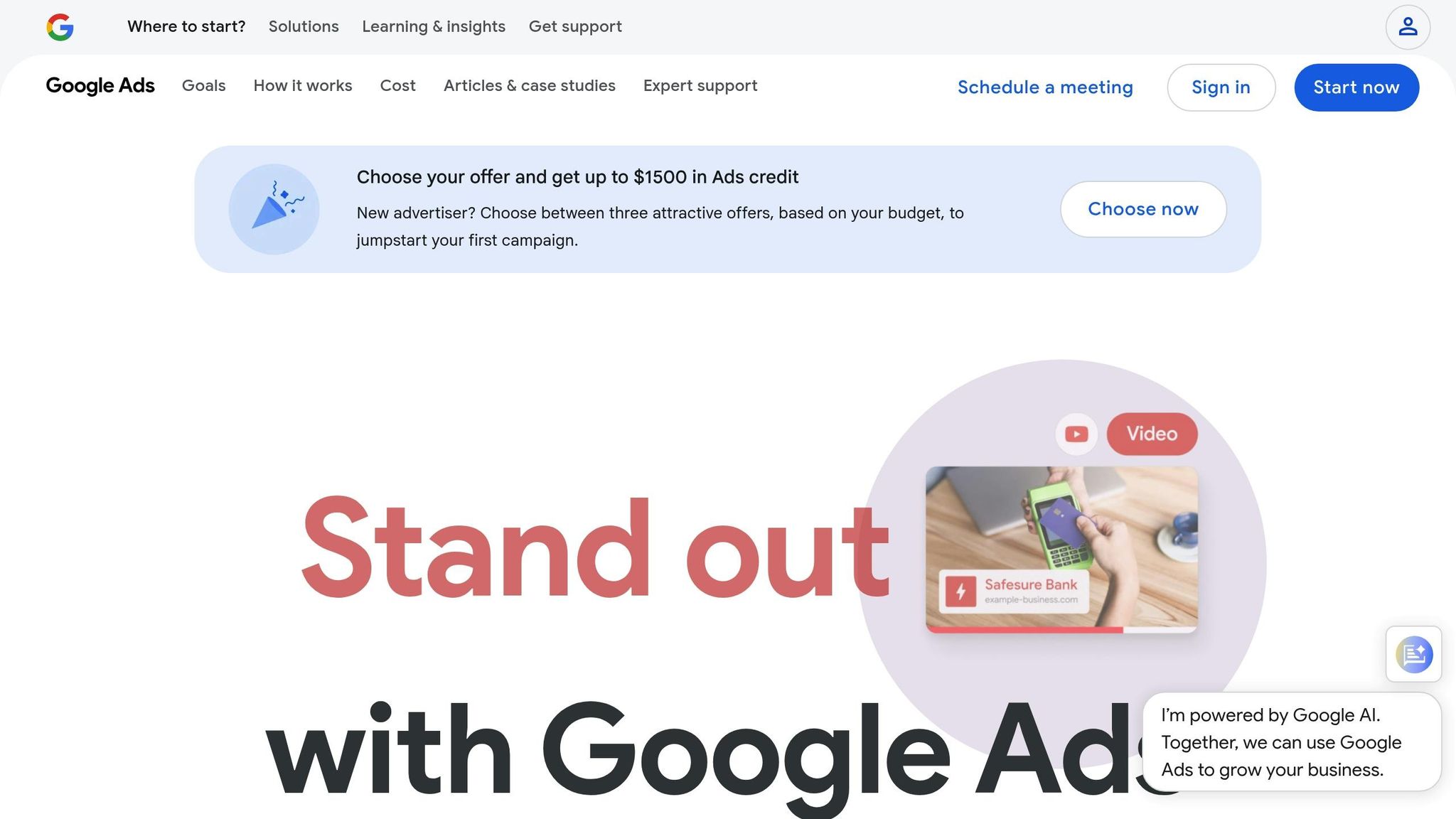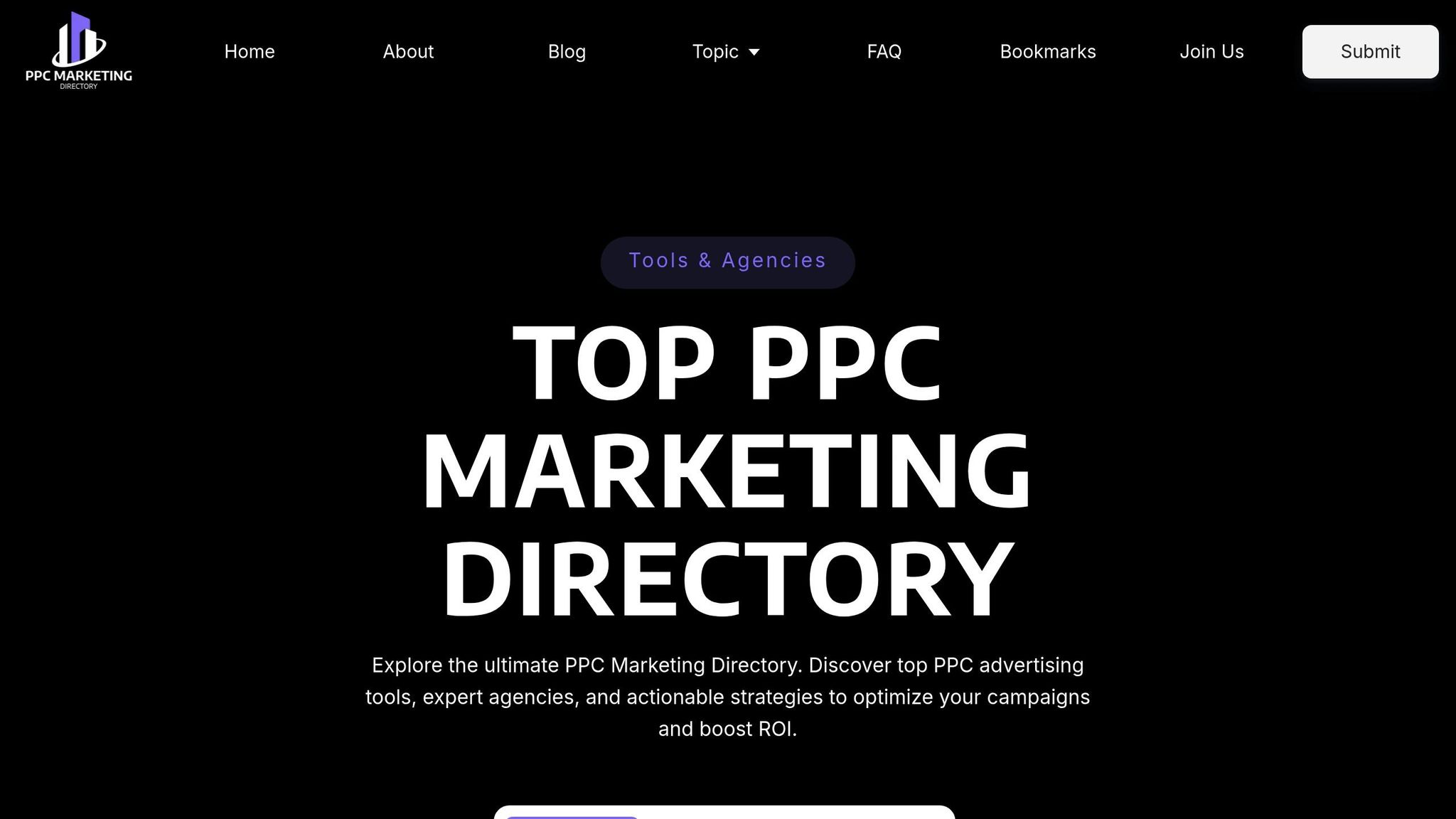Want to improve your PPC campaigns? Start by analyzing your competitors' keywords. Competitor keyword discovery reveals the search terms your rivals use to attract leads and drive traffic. By studying their strategies, you can identify gaps, refine your ad copy, and allocate your budget more effectively.
Key Takeaways:
- Why it matters: Understand competitors’ keyword strategies to avoid wasting money and focus on high-performing terms.
- How it works: Use tools like SEMrush, SpyFu, and Google Ads Auction Insights to uncover keywords, costs, and trends.
- Actionable steps: Identify competitors, analyze their ads and keywords, and integrate findings into your campaigns for better performance.
This process isn't a one-time task. Continuous monitoring ensures your PPC strategy stays competitive and adapts to changes in the market. Let’s explore how to make it work for you.
How To Check Competitors Google Ads Keywords

Finding Your PPC Competitors
Pinpointing your PPC competitors is the first step toward effective keyword analysis, which we'll explore later in this guide. To do this, you need to identify who is actively bidding on the keywords you’re targeting. This involves more than just knowing your usual business rivals - it includes companies, affiliates, or even unexpected contenders who show up in paid search results for your chosen keywords.
How to Find Competitors
To build a solid list of competitors, use a mix of manual research and specialized tools. Start by focusing on your most important keywords and checking who consistently appears in paid search results. This hands-on approach will give you a clear picture of your real competition.
Manual SERP analysis is a reliable way to begin identifying competitors. Search your target keywords on Google and note the ads that appear. Digital Marketing Specialist Brian Ferritto from 42connect shares his approach:
"We identify our client's competitors by starting with keyword research. We run those keywords to see the top results, then we note the companies that are running ads based on our keyword list. The companies that repeatedly show up for our top keywords become the 'shortlist' of competitors we are trying to beat."
If you’re targeting multiple locations, make sure to search from different regions. Use incognito mode to avoid personalized results and test searches at various times of the day, as some competitors may run ads on specific schedules.
Once you’ve identified some competitors, competitive intelligence tools can help you dig deeper. Platforms like SEMrush, SpyFu, and Ahrefs reveal additional details, such as domains bidding on your keywords, estimated budgets, keyword overlap, and bidding trends that manual research might miss.
If you’re already running campaigns, Google Ads Auction Insights is another valuable resource. This free tool provides data on other advertisers in the same auctions, including metrics like impression share and overlap rate. For social media advertising, the Facebook Ad Library allows you to explore active ads on Meta platforms, giving you a glimpse into competitors’ messaging and creative strategies.
Don’t stop there - check Google Analytics referrals and participate in industry forums or social media groups where your audience is active. These spaces can reveal additional PPC advertisers you might not have noticed.
Aim to track 10–15 competitors for a well-rounded analysis. With your competitor list in hand, you can move on to understanding their business models for a sharper keyword strategy.
Understanding Competitor Business Models
Once you’ve identified your PPC competitors, the next step is to analyze their business models. This helps you understand their approach to keyword targeting and how aggressive they might be in bidding.
- Direct competitors: These are businesses offering the same products or services to the same audience. They’re often your biggest threat in PPC auctions, as they’re likely to bid aggressively on your brand terms and core product keywords to capture your potential customers.
- Indirect competitors: These companies address similar customer needs but with different solutions. For example, if you sell meal-planning software, an indirect competitor might offer a meal delivery service. They tend to focus on broader, problem-solving keywords rather than specific product terms.
- Affiliate marketers and search arbitragers: These competitors operate differently - they’re not selling products but earning commissions or arbitraging traffic. Their smaller margins often make them easier to outbid.
By examining competitors’ target markets, audiences, and pricing strategies, you can uncover keyword gaps and opportunities that might not be obvious through keyword analysis alone. For instance, a competitor targeting enterprise clients will likely use different keywords than one focused on small businesses. Similarly, location-based businesses may prioritize regional keywords.
Stuart Pereira, Campaign Manager at WSI Comandix, highlights the value of understanding competitors’ strategies:
"Our favorite tool for PPC competitor analysis is Semrush. It gives access to competitor PPC keywords, estimated traffic amounts, likely CPCs, etc. Also, for active search campaigns, Auction Insights in Google Ads is key to knowing how your campaigns are faring vs. your competition."
Best Tools for Competitor Keyword Discovery
Once you've gathered insights on your competitors, the next step is to use tools that can turn those insights into actionable strategies. The right tools can help you move beyond guesswork, offering data-driven clarity on your competitors' keyword strategies. With so many PPC competitor analysis tools available, selecting the right one can be the key to uncovering profitable opportunities and staying ahead in the game.
Popular Tool Options
SEMrush is a go-to platform for PPC keyword data, starting at $149 per month. It provides access to data from over 140 countries and offers insights into both organic and paid search strategies. Alyssa Galik, Lead Strategist and PPC expert at HawkSEM, highlights the importance of competitor analysis:
"Competitor analysis provides a visual of the PPC landscape before you enter it. It helps you understand how your strategy is working and where you may have gaps. Looking at the data on an ongoing basis provides information on position, budgets, copy, and opportunity."
SpyFu, priced at $33 per month, provides access to 19 years' worth of competitor ad history, covering 7 billion results across 109 million domains. Its simple interface makes it easy to search by website or keyword, making it a favorite for many marketers.
Ahrefs, starting at $99 per month, combines its well-known backlink database with competitor keyword analysis. This tool is ideal for marketers who want to examine both organic and paid strategies in one convenient platform.
PPC.io offers a freemium model that starts at $0 and scales based on usage, with paid plans beginning at $99 per month. It uses AI to create actionable insights and battle plans.
Google Ads Auction Insights is a free option for advertisers running campaigns. While it doesn't provide keyword-level data, it offers valuable metrics like impression share, overlap rates, and position details directly from Google's auction system.
Important Tool Features
When choosing a competitor keyword discovery tool, certain features can make a big difference. Historical data tracking is essential for understanding how competitor strategies have evolved over time. Tools that offer keyword gap analysis can help you pinpoint areas where your competitors rank but you don't, revealing untapped opportunities.
The ability to analyze ad copy and landing pages alongside keyword data adds valuable context, helping you understand why specific keywords perform well. Tools that provide traffic and cost estimates can also guide your planning process. For example, Moz's Keyword Explorer boasts a 95% accuracy rate for predicting search volume, making it a reliable option for forecasting.
For businesses running international campaigns, multi-country data access is crucial. SEMrush, with its coverage of over 140 countries, is particularly useful for this purpose. Lastly, export and integration options ensure that your team can easily share and incorporate insights into their workflows.
Using the Top PPC Marketing Directory

The Top PPC Marketing Directory is a one-stop resource for discovering and comparing keyword research tools and services. It simplifies the process of finding vetted tools tailored to competitor keyword discovery, keyword research, and performance tracking. This curated approach saves you time and helps you quickly identify tools that align with your specific needs and budget.
For agencies or consultants who prefer to outsource this task, the directory also connects you with expert services capable of managing competitor keyword discovery. By integrating these tools and services into your strategy, you can fine-tune your PPC campaigns and focus on what truly matters - optimizing your performance and maximizing results.
Step-by-Step Competitor Keyword Discovery Process
Finding the right keywords through competitor analysis can give your PPC campaigns a serious edge. By following a clear, organized process, you can uncover opportunities you might have missed while steering clear of common mistakes. This five-step guide will help you turn competitor data into actionable insights for refining your PPC strategy.
Step 1: Collect Competitor Information
Start by building a database of competitors using keyword searches and tools like Google Ads Transparency Center and Auction Insights. Search for relevant keywords in your niche and note which companies frequently appear. These are likely your direct competitors.
Go beyond the tools - compare performance metrics using analytics platforms, put yourself in the customer’s shoes to experience their offerings, and review real-time ad transparency data. Keep in mind that more than 65% of small and midsized businesses run their own PPC campaigns. This means you're often up against a mix of professional agencies and in-house teams with varying levels of expertise and budgets.
Step 2: Review Competitor Pages and Ads
Competitor landing pages and ads are treasure troves of keyword insights. Look for keywords in their meta titles, descriptions, headlines, and body content. Pay attention to how they group these keywords - are they organized by themes, intent, or unique selling points?
Also, check ad extensions like sitelinks or structured snippets to see how they’re enhancing their ads. Use the AIDA model (Attention, Interest, Desire, Action) to evaluate the effectiveness of their landing pages and pinpoint strategies you can adapt for your campaigns.
Step 3: Check Keyword Metrics
Once you’ve identified potential keywords, it’s time to dig into the data. Analyze metrics like search volume, competition, cost-per-click (CPC), and ad positions. Compare organic and paid keyword performance to identify those that drive the most conversions. Don’t forget to track seasonal trends - these insights can help you plan your budgets and schedules more effectively.
Step 4: Find Keyword Gaps and Opportunities
Competitor analysis can reveal gaps in your keyword strategy. Look for terms where your competitors rank but you don’t - these could represent untapped market segments. Pay special attention to long-tail keywords. These more specific phrases often face less competition and can lead to higher conversion rates.
Study your competitors’ ad copy to understand their tone, messaging, and calls-to-action. This can inspire ideas for your own A/B testing. You can also segment competitors based on factors like budget, target keywords, and audience focus. Don’t overlook indirect competitors - businesses that solve similar problems for your audience but in different ways.
Step 5: Track Seasonal and Strategy Changes
Competitors don’t stay static, and neither should you. Monitor their activity over time to spot trends and shifts in strategy. For instance, they might adjust keywords based on seasonal demand, new product launches, or changing market conditions.
Take note of changes in messaging or signs of expansion into new markets - these could signal opportunities or threats. Tools from resources like the Top PPC Marketing Directory can help automate competitor monitoring, making it easier to stay informed. Use these insights to fine-tune your campaigns, as we’ll explore further in the next section on integrating competitor metrics into your PPC plans.
sbb-itb-89b8f36
Adding Competitor Insights to Your PPC Strategy
Once you've gathered competitor keyword data, the next step is turning those insights into actionable strategies. Let’s dive into how you can use this information to enhance your PPC campaigns.
Improving Targeting and Keyword Lists
Take a close look at your keyword list and compare it to the data you've collected on competitors. This process can reveal untapped opportunities, including high-performing keywords that aren't currently in your campaigns. Focus on three key areas:
- Add missing high-performing keywords: These can help you expand your reach and attract more traffic.
- Target low-competition keywords: These often allow you to secure better ad positions at a lower cost.
- Leverage long-tail keywords: These tend to drive higher conversion rates by aligning closely with specific search intent.
When you identify new keywords, assess their potential by examining factors like search volume, competition level, and relevance to your business. Build new ad groups around these keywords and craft ad copy that directly addresses the search intent behind each term.
Budget allocation also becomes more precise when you understand where competitors are focusing their efforts. If you notice heavy investment in certain keyword categories, you can decide whether to compete directly or redirect your budget to areas where you may be under-spending.
Updating Ad Copy and Bidding Strategies
With a refined keyword list in hand, the next step is to optimize your ad copy and bidding tactics. Study your competitors' ads - pay attention to their headlines, descriptions, and calls-to-action (CTAs). Use this analysis to create messaging that sets your ads apart by emphasizing your unique strengths and backing up claims with solid facts.
Run A/B tests on different headlines, descriptions, and CTAs to pinpoint what resonates most with your audience.
Adjust your bidding strategies based on the competitive landscape. For example, if you're targeting competitor brand names, consider a max clicks bidding strategy with a set cost-per-click (CPC) cap to control spending. Start with a conservative budget and scale up as you see positive performance metrics. For highly competitive general keywords, try increasing bids during peak conversion times and scaling back during less active periods.
When competitors are aggressively bidding on specific keywords, decide whether it’s worth competing directly - based on the potential return on investment - or if it’s better to focus on alternative keywords with similar intent but less competition. Keeping an eye on your quality scores can also help ensure your ads remain competitive, even against higher bids.
Continuous Monitoring and Updates
Refining your targeting and bids is just the beginning. To maintain your edge, you need to continuously monitor your campaigns. Competitor analysis is not a one-and-done task; the PPC landscape is always changing as competitors test new ads, tweak bids, and shift strategies.
Establish a regular schedule for monitoring - monthly for your main competitors and quarterly for a broader set of rivals. Leverage alert systems in PPC tools to stay informed about significant changes in the market.
By keeping a close watch, you can quickly adapt to trends like seasonal demand shifts, new product launches, or evolving competitor tactics. For example, knowing that the average cost-per-click across industries has risen by 12.88% year-over-year can help you adjust your expectations, while the fact that 65% of industries are seeing higher conversion rates offers valuable context.
Regularly update your campaigns based on these insights. Pause underperforming ads, reallocate budgets to high-potential opportunities, and refresh your ad copy to stay relevant. Agility and data-driven decision-making are key to staying ahead.
To simplify the process, use tools like those listed in the Top PPC Marketing Directory. These resources can automate much of the monitoring work, saving time and reducing the need for manual research while keeping your team informed about competitor movements.
Conclusion
Summarizing the strategies discussed earlier, this section focuses on the importance of competitor keyword discovery in PPC campaigns. By leveraging insights into your competitors' tactics, you can fine-tune your paid search strategies to stand out in a crowded digital marketplace. This isn't just about copying what others are doing - it's about identifying gaps and opportunities that can elevate your performance.
Through competitor keyword analysis, you gain access to valuable information, such as the terms driving their traffic and leads. This knowledge empowers you to refine your approach and achieve better results.
Key Points
Competitor keyword discovery helps you allocate your budget more effectively by identifying areas of high spending and spotting underused opportunities. It also improves your ad messaging. By analyzing what resonates with your shared audience, you can craft headlines and descriptions that not only grab attention but also differentiate your brand. Pair this with optimized landing pages for a seamless user experience that boosts conversions.
Tools like Google Ads Auction Insights allow you to compare your performance to competitors, offering data-driven insights to refine your strategy. Additionally, identifying untapped keywords - valuable terms that competitors may have overlooked - can help you attract cost-effective traffic and maximize returns.
With these benefits in mind, it’s time to focus on actionable next steps.
Next Steps for Marketers
Begin by integrating competitor insights into your PPC campaigns. Revisit your keyword lists, adjust bids for top-performing terms, and tweak your ad copy based on successful examples from competitors.
Create new ad groups targeting opportunities uncovered during your analysis. Organize related keywords into segments, write tailored ad copy for each, and develop landing pages that align with user intent. This targeted approach can help you capture traffic that others might be missing.
Explore untapped keywords by evaluating their relevance and potential for traffic and conversions. Start testing with modest bids, then scale up based on performance.
To streamline your efforts, leverage tools from resources like the Top PPC Marketing Directory. These platforms can simplify keyword research, bid management, and performance tracking, making it easier to apply competitor insights effectively.
Focus on making impactful changes that are easy to implement. Set measurable goals, use A/B testing to validate your adjustments, and review performance data regularly to guide further refinements.
Stay proactive by monitoring your campaigns consistently. Use automated alerts for significant metric changes and keep an eye on shifts in competitor strategies or market trends. Be ready to adjust bids, refresh ad copy, and update landing pages as needed.
Finally, measure your success with clear KPIs that align with your business goals. Metrics like return on ad spend (ROAS), cost per acquisition (CPA), and conversion rates can provide a clear picture of your campaign's effectiveness. Attribution modeling can also help you understand the broader impact of your PPC efforts.
Competitor keyword discovery isn’t just a helpful tactic - it’s a critical element for staying competitive and maximizing your advertising ROI. By putting these strategies and tools into action, you’ll be well-prepared to outpace your rivals and achieve long-term success.
FAQs
How do I find the most relevant competitors for my PPC campaigns across different regions?
How to Identify Key Competitors for PPC Campaigns Across Regions
To pinpoint your main competitors in PPC campaigns across different regions, start by diving into geographic targeting. This will help you figure out which areas are most relevant to your business goals. Tools like SEMrush, SpyFu, and Similarweb can be incredibly useful for uncovering regional advertising strategies. These platforms can also help you identify competitors actively running campaigns in those specific locations.
Beyond tools, it's important to dig into local market trends. Keep an eye on ad performance in the regions you're targeting to spot businesses vying for the same audience. By combining these insights, you can fine-tune your campaigns to outpace competitors in each market.
What are the benefits of using tools like SEMrush or SpyFu for discovering competitor keywords instead of doing it manually?
Using tools like SEMrush or SpyFu to uncover competitor keywords can save you a ton of time compared to manual research. These platforms are designed to deliver data-rich insights into what’s driving your competitors’ success.
They go beyond just listing keywords. With features like keyword ranking analysis, PPC campaign breakdowns, and even historical performance data, these tools give you a well-rounded view of your competitors’ strategies. Manual research just can’t compete with the level of detail and efficiency these tools bring to the table, making them a smart choice for fine-tuning your marketing efforts.
How can I use competitor keyword insights to improve my PPC ads and bidding strategies?
Competitor keyword insights are a goldmine for fine-tuning your PPC campaigns. By spotting high-performing keywords and studying effective messaging tactics, you can craft ads that resonate with your audience and hit the mark. The key is to use this data to create ads with engaging, relevant copy that targets those keywords effectively.
Don’t overlook competitors' bidding patterns - they can reveal opportunities to adjust your bids strategically. This way, you can stay competitive without blowing through your budget.
Take it a step further by digging into their landing pages and ad extensions. What elements are driving their conversions? Use this knowledge to refine your own approach. And remember, PPC success isn’t a one-and-done effort. Keep reviewing and tweaking your campaigns to stay in sync with market trends and maintain peak performance.


